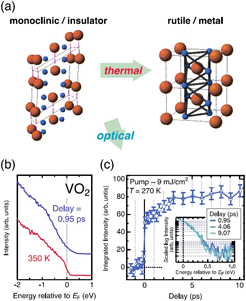Ultrafast Photo-Induced Transition of an Insulating VO2 Thin Film into a Non-Rutile Metallic State
Shin Group
Vanadium dioxide (VO2) is an exemplary strongly correlated material known for its dramatic insulator-to-metal transition around room temperature (Fig. 1(a)). The phase transition can also be triggered by external stimuli such as electric gating and light irradiation. VO2 thus provides an interesting platform for novel functionalities. By using time-resolved photoemission spectroscopy (TrPES) implemented by a high-harmonic generation method, we investigated the ultrafast photo-induced transition of VO2, and provide insights into the non-equilibrium dynamics governed by strong correlations.

Fig. 1. Insulator-to-metal transition of VO2. (a) Structural change from monoclinic insulating phase to rutile metal phase upon the thermal transition. (b) Time-resolve spectrum at delay = 0.95 ps (F ~ 9 mJ/cm2, 270 K) compared with a static photoemission spectrum of a rutile metallic state recorded at 350 K. (c) Time evolution of spectral weight over [-0.2, 0.2 eV]. The inset shows the unoccupied side of the spectra for delay = 0.95, 4.05, 9.07 ps in the logarithmic scale.
The valence-band spectrum of a VO2 thin film was monitored in a pump-and-probe TrPES configuration. A metallic state emerged when the sample was impinged by a 170-fs pulse above a critical fluence F = 6 mJ/cm2, which was directly evidenced by the ultrafast increase of the spectral weight at the Fermi level (EF). The transition was accompanied by a spectral-weight transfer on a 1-eV scale characteristic of strong electron correlations. The photo-induced metallic state exhibited a unique spectrum that tails up to ~0.4 eV above EF. This indicates that the emergent metallic state is different from the rutile state (Fig. 1(b)). After the impulsive impact, the spectral weight at EF further increased until ~3 ps (Fig. 1(c), inset), indicating that the metallic state grew proliferatively. The ~0.4-eV tail also persisted for > 3 ps, the behavior of which cannot be explained by the photo-response of typical Mott insulators that relaxes within ~1 ps. These observations emphasize the importance of non-electronic degrees of freedom in the photo-induced dynamics of VO2.
References
- [1] R. Yoshida, T. Yamamoto, Y. Ishida, H. Nagao, T. Otsuka, K. Saeki, Y. Muraoka, R. Eguchi, K. Ishizaka, T. Kiss, S. Watanabe, T. Kanai, J. Itatani, and S. Shin, Phys. Rev. B 89, 205114 (2014).
